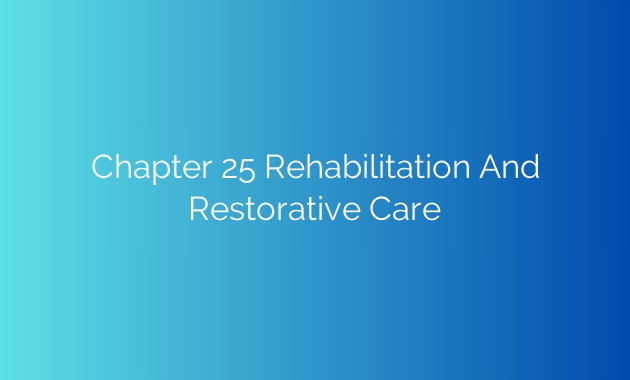Contents
- 1 Chapter 25 Rehabilitation And Restorative Care
- 1.1 Introduction
- 1.2 The Importance of Rehabilitation
- 1.3 Types of Rehabilitation
- 1.4 The Rehabilitation Process
- 1.5 Restorative Care
- 1.6 Benefits of Rehabilitation and Restorative Care
- 1.7 Challenges in Rehabilitation and Restorative Care
- 1.8 Conclusion
- 1.9 FAQs about Chapter 25 Rehabilitation And Restorative Care
- 1.9.1 1. What is the difference between rehabilitation and restorative care?
- 1.9.2 2. Who can benefit from rehabilitation and restorative care?
- 1.9.3 3. Are rehabilitation and restorative care covered by insurance?
- 1.9.4 4. How long does the rehabilitation process typically take?
- 1.9.5 5. Are there alternative therapies available in rehabilitation and restorative care?
Chapter 25 Rehabilitation And Restorative Care
Introduction
In Chapter 25, we delve into the important topic of rehabilitation and restorative care. This chapter focuses on the various aspects of providing care and support to individuals who have experienced debilitating injuries or illnesses, helping them regain their independence and improve their overall quality of life. Rehabilitation and restorative care play a vital role in the recovery process, offering individuals the opportunity to regain lost skills and abilities.
The Importance of Rehabilitation
Rehabilitation is a crucial component of healthcare as it aims to restore function, reduce disability, and improve the overall well-being of patients. Whether it’s recovering from a stroke, managing chronic pain, or restoring mobility after a serious accident, rehabilitation offers a comprehensive approach to healing that encompasses physical, psychological, and emotional aspects.
Types of Rehabilitation
Rehabilitation can be categorized into various types depending on the specific needs of the individual. Physical rehabilitation focuses on improving mobility, strength, and balance. Occupational rehabilitation aims to restore the ability to perform daily activities and tasks. Speech and language rehabilitation focuses on restoring communication skills, while cognitive rehabilitation targets the improvement of cognitive abilities.
The Rehabilitation Process
The rehabilitation process typically begins with a thorough assessment by a multidisciplinary team of healthcare professionals. This assessment helps identify the individual’s specific needs and goals, allowing for the development of a personalized rehabilitation plan. Throughout the process, individuals receive targeted therapies, such as physical exercises, adaptive equipment, and psychological counseling, to aid in their recovery.
Restorative Care
Restorative care is closely related to rehabilitation and focuses on maintaining or improving an individual’s existing abilities. This type of care is often provided to individuals with chronic conditions or disabilities, aiming to prevent further decline and promote independent functioning. Restorative care may involve a range of interventions, including physical therapy, medication management, and assistive devices.
Benefits of Rehabilitation and Restorative Care

The benefits of rehabilitation and restorative care are numerous. Firstly, these types of care help individuals regain independence and improve their overall quality of life. By focusing on recovery and restoration, individuals can regain control over their lives and engage in activities that bring them joy. Additionally, rehabilitation and restorative care can reduce the need for long-term care and hospitalization, resulting in cost savings for individuals and healthcare systems.
Challenges in Rehabilitation and Restorative Care
While rehabilitation and restorative care offer immense benefits, there are also challenges that need to be addressed. Adequate funding, access to specialized services, and availability of trained professionals are some of the key challenges faced in this field. Additionally, the diverse needs and preferences of individuals require a personalized approach to care, which can be demanding in terms of resources and coordination.
Conclusion
In conclusion, Chapter 25 explores the important topics of rehabilitation and restorative care. These areas of healthcare play a critical role in helping individuals recover from injuries or illnesses and regain their independence. By providing targeted therapies and support, rehabilitation and restorative care improve the overall well-being and quality of life for individuals in need. Despite the challenges, the benefits of these types of care far outweigh the obstacles, making them an essential component of the healthcare system.
FAQs about Chapter 25 Rehabilitation And Restorative Care
1. What is the difference between rehabilitation and restorative care?
Rehabilitation aims to restore lost function and reduce disability, whereas restorative care focuses on maintaining or improving existing abilities.
2. Who can benefit from rehabilitation and restorative care?
Rehabilitation and restorative care can benefit individuals recovering from injuries, surgeries, strokes, chronic conditions, or those with disabilities.
3. Are rehabilitation and restorative care covered by insurance?
Insurance coverage for rehabilitation and restorative care can vary. It is essential to consult your insurance provider to understand the specific coverage available to you.
4. How long does the rehabilitation process typically take?
The duration of the rehabilitation process varies depending on the individual’s condition and goals. It can range from a few weeks to several months.
5. Are there alternative therapies available in rehabilitation and restorative care?
Yes, complementary and alternative therapies, such as acupuncture, yoga, and art therapy, can be incorporated into rehabilitation and restorative care plans based on individual needs and preferences.
